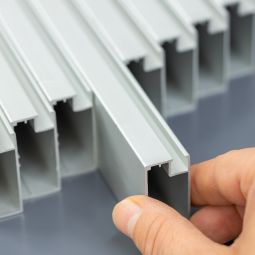
When it comes to industrial and construction applications, the choice between steel and aluminum for extrusion processes is critical. Both materials boast unique properties that make them suitable for different uses. Steel, known for its exceptional strength and durability, is often the material of choice for heavy-duty structures. On the other hand, Aluminum offers a lightweight yet robust alternative, making it ideal for applications where ease of handling and resistance to corrosion are paramount.
Let's look at the difference between steel and aluminum extrusion to understand which is better for your project.
One of the biggest differences between steel and aluminum extrusion is their strength. Steel has a higher tensile strength than aluminum, meaning it can withstand heavier loads without bending or breaking. Steel is excellent for structural applications like bridges, buildings, and heavy machinery. On the other hand, aluminum has a lower tensile strength but offers a higher stiffness-to-weight ratio, making it suitable for applications where weight is a factor. For example, aluminum is common in the aerospace industry due to its lightweight yet strong properties.
Durability is another essential factor when choosing between steel and aluminum extrusion. Steel has exceptional durability and the ability to withstand extreme weather conditions, making it suitable for outdoor and high-traffic areas. On the other hand, aluminum isn’t as durable as steel and can get damaged easily if exposed to harsh environments. However, advancements in coating technology have made it possible to improve the durability of aluminum extrusions, making them more resistant to corrosion and wear.
Cost is a significant consideration in any construction or industrial project. Generally, aluminum extrusion is more expensive than steel due to its production process and properties. However, some factors can influence the cost of both materials. For instance, while steel may be cheaper upfront, it requires regular maintenance and may need replacement sooner than aluminum, which has a longer lifespan.
Another important factor to consider is the machinability of both materials. Steel is easier to machine and weld, making it a popular choice for various applications that require precise cutting and shaping. On the other hand, aluminum can be challenging to machine due to its lower melting point and tendency to gum up on cutting tools. However, technological advancements have enabled overcoming these challenges, making aluminum extrusion increasingly popular in various industries.
Both steel and aluminum extrusion have unique properties that make them suitable for different applications. While steel offers exceptional strength and durability, aluminum provides a lightweight yet robust alternative. The choice between the two materials ultimately depends on your project's specific needs and requirements. Consider factors like strength, durability, cost, and machinability to determine which material best fits your application. With the right choice, you can ensure that your project will be successful and long lasting.
If you need extruded aluminum fabrication and want to learn more about our services, A-Line Automation can help. Our team of experts will be happy to help you find the best solution for your project.